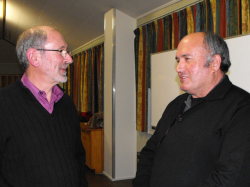
Following a buffet Chinese meal, committee member Ann White chaired the Timaru Branch meeting on 18 August. Members stood for a minute’s silence in memory of Branch Chairman Jim Hunter who had died suddenly four days earlier. South Island vice-president Dave Adamson attended the meeting and brought greetings from the Society.
Speaker for the evening was Alan Laurie whose company, Laurie Forestry Ltd, exports large quantities of South Island logs to China. New Zealand is now the top exporter of logs to China. In the past two years Alan has made four trips to China to develop closer relationships with the companies who import and mill the logs. On his last visit he took a group of NZ forestry people with him. Alan’s visits have assisted him to build up trust and a personal relationship with the importers which is an essential part of doing business in China. He has hosted a group of Chinese businessmen to NZ to give them an understanding of our timber industry. Many of the senior people in charge of these often multi-billion dollar companies seem very young by our standards.
Most of the logs are milled into 75 x 50mm timber which is used as temporary support and framing for concrete placement in the booming construction industry. By western standards the mills are very basic with most tasks being done manually. “Health and Safety” isn’t an issue with little protective gear evident. In spite of all the workplace hazards, jandals were frequently worn. A prominent slogan in a plywood factory said “If you do not work hard today, you will not have a job tomorrow”. Wage inflation is significant and if this continues it will reduce the huge cost advantage Chinese mills currently enjoy.
Alan has reservations about how long the frenetic building construction in China can continue, suggesting that sooner or later the supply of new buildings must catch up with demand.












